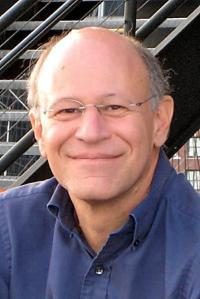Larry Abbott, PhD
- William Bloor Professor of Theoretical Neuroscience
- Professor of Physiology and Cellular Biophysics (in Biological Sciences and in the Mortimer B Zuckerman Mind Brain Behavior Institute)

Overview
Academic Appointments
- William Bloor Professor of Theoretical Neuroscience
- Professor of Physiology and Cellular Biophysics (in Biological Sciences and in the Mortimer B Zuckerman Mind Brain Behavior Institute)
Administrative Titles
- Co-Director, Center for Theoretical Neuroscience
Gender
- Male
Credentials & Experience
Education & Training
- PhD, 1977 Physics, Brandeis University
Committees, Societies, Councils
- Member, Kavli Institute for Brain Science
- Member of the Motor Neuron Center, Columbia University
- Senior Fellow, HHMI Janelia Farm Research Campus
- American Academy of Arts and Sciences
- Fellow, American Association for the Advancement of Science
- Steering Committee, Safra Center for Brain Sciences, Hebrew University
- Scientific Advisory Panel, Gatsby Unit, UCL
- Advisory Council for Physics Department, Princeton University
- Scholars Selection Committee, McKnight Foundation
- Mindscope Advisory Council, Allen Institute for Brain Science
- Scientific Advisory Board, Champalimaud Neuroscience Program
- Brain and Cognitive Sciences Visiting Committee, MIT
- Scientific and Academic Advisory Committee, Weizmann Institute
- Executive Committee, Simons Collaboration on the Global Brain
Honors & Awards
- 2004 NIH Director’s Pioneer Award
- 2010 Swartz Prize for Theoretical and Computational Neuroscience
- 2013 First Annual Prize in Mathematical Neuroscience
- 2013 Irving Institute Mentor of the Year Award
Research
Computational and Mathematical Analysis of Neurons and Neural Networks
Larry Abbott's research involves the computational modeling and mathematical analysis of neurons and neural networks. Analytic techniques and computer simulation are used to study how single neurons respond to their many synaptic inputs, how neurons interact to produce functioning neural circuits, and how large populations of neurons represent, store, and process information. Areas of particular interest include spike-timing dependent forms of synaptic plasticity, transformations of sensory encoding in olfaction, and the dynamics of internally generated activity and signal propagation in large neural networks.
Most neural activity is generated internally but nervous systems are nevertheless highly sensitive to external influences such as sensory stimuli. We study how stimulus driven and internally generative activity interact and combine to produce responses. We also model how chaotic ongoing activity can be harnessed and controlled to produce useful motor output. We are interested in representing perception not as a passive analysis of sensory input, but as a dynamic process that involves modeling the external world, making inferences about predictable events and noting when something unexpected happens. This requires both representing sensory stimuli and modifying ongoing activity through synaptic plasticity.
Research Interests
- Cognitive/Systems Neuroscience
- Computation and Theory
- Neurobiology of Learning and Memory
- Theoretical Neuroscience
Selected Publications
- Stern M, Sompolinsky H, Abbott LF. (2014). Dynamics of random neural networks with bistable units. Phys Rev E Stat Nonlin Soft Matter Phys. 90:062710.
- Aso Y, Hattori D, Yu Y, Johnston RM, Iyer NA, Ngo TT, Dionne H, Abbott LF, Axel R, Tanimoto H, Rubin GM. (2014). The neuronal architecture of the mushroom body provides a logic for associative learning. Elife. 3:e04577.
- Le Masson G, Przedborski S, Abbott LF. (2014). A computational model of motor neuron degeneration. Neuron. 83:975-988. Erratum in: Neuron. 2014;83:990.
- Wayne G, Abbott LF. (2014). Hierarchical control using networks trained with higher-level forward models. Neural Comput. 26:2163-2193.
- Fink, A.J.P., Azim, E., Croce, K.R., Huang, Z.J., Abbott, L.F. and Jessell, T.M. (2014) Presynaptic Inhibition of Spinal Sensory Feedback Ensures Smooth Forelimb Movement. Nature. 509:43-48.
- Kennedy, A., Wayne, G., Kaifosh, P., Alvina, K., Abbott, L.F. and Sawtell, N.B. (2014) A Temporal Basis for Predicting the Sensory Consequences of Motor Commands in an Electric Fish. Nature Neurosci. 17:416-424.Kato, S., Xu, Y., Cho, C., Abbott, L.F. and Bargmann, C. (2014) Temporal Responses of C. Elegans Chemosensory Neurons are Matched to Behavior. Neuron 81:616-628.
- Schaffer, E.S., Ostojic, S. and Abbott L.F. (2013) A Complex-Valued Firing-Rate Model that Approximates the Dynamics of Spiking Networks. PLoS Comput. Biol. 9:e1003301.
- Caron, S.J.C, Ruta, V., Abbott, L.F. and Axel, R. (2013) Random Convergence of Afferent Olfactory Inputs in the Drosophila Mushroom Body. Nature 497:113-117.
- Babadi, B. and Abbott, L.F. (2013) Pairwise Analysis Can Account for Network Structures Arising from Spike-Timing Dependent Plasticity. PLoS Comput. Biol. 9:e1002906.
- Monaco, J.D. and Abbott, L.F. (2011) Modular Realignment of Entorhinal Grid Cell Activity as a Basis for Hippocampal Remapping. J. Neurosci. 31:9414-9425.
- Rajan, K., Abbott, L.F. and Sompolinsky, H. (2010) Stimulus-Dependent Suppression of Chaos in Recurrent Neural Networks. Phys. Rev. E 82:011903.
- Luo, S., Axel, R. and Abbott, L.F. (2010) Generating Sparse and Selective Third-Order Responses in the Olfactory System of the Fly. Proc. Natl. Acad. Sci. USA 107:10713-10718.
- Sussillo, D. and Abbott, L.F. (2009) Generating Coherent Patterns of Activity from Chaotic Neural Networks. Neuron 63:544-557.
- George, M.S., Abbott, L.F. and Siegelbaum, S.A. (2009) Hyperpolarization-Activated HCN Cation Channels Exert Inhibit Subthreshold EPSPs Through Interactions with M-Type K+ Channels. Nature Neurosci. 12:577-584.
- Vogels, T.P. and Abbott, L.F. (2009) Gating Multiple Signals through Detailed Balance of Excitation and Inhibition in Spiking Networks. Nature Neurosci. 12:483-491.
- Abbott, L.F. (2008) Theoretical Neuroscience Rising. Neuron 60:489-495.
For a complete list of publications, please visit PubMed.gov